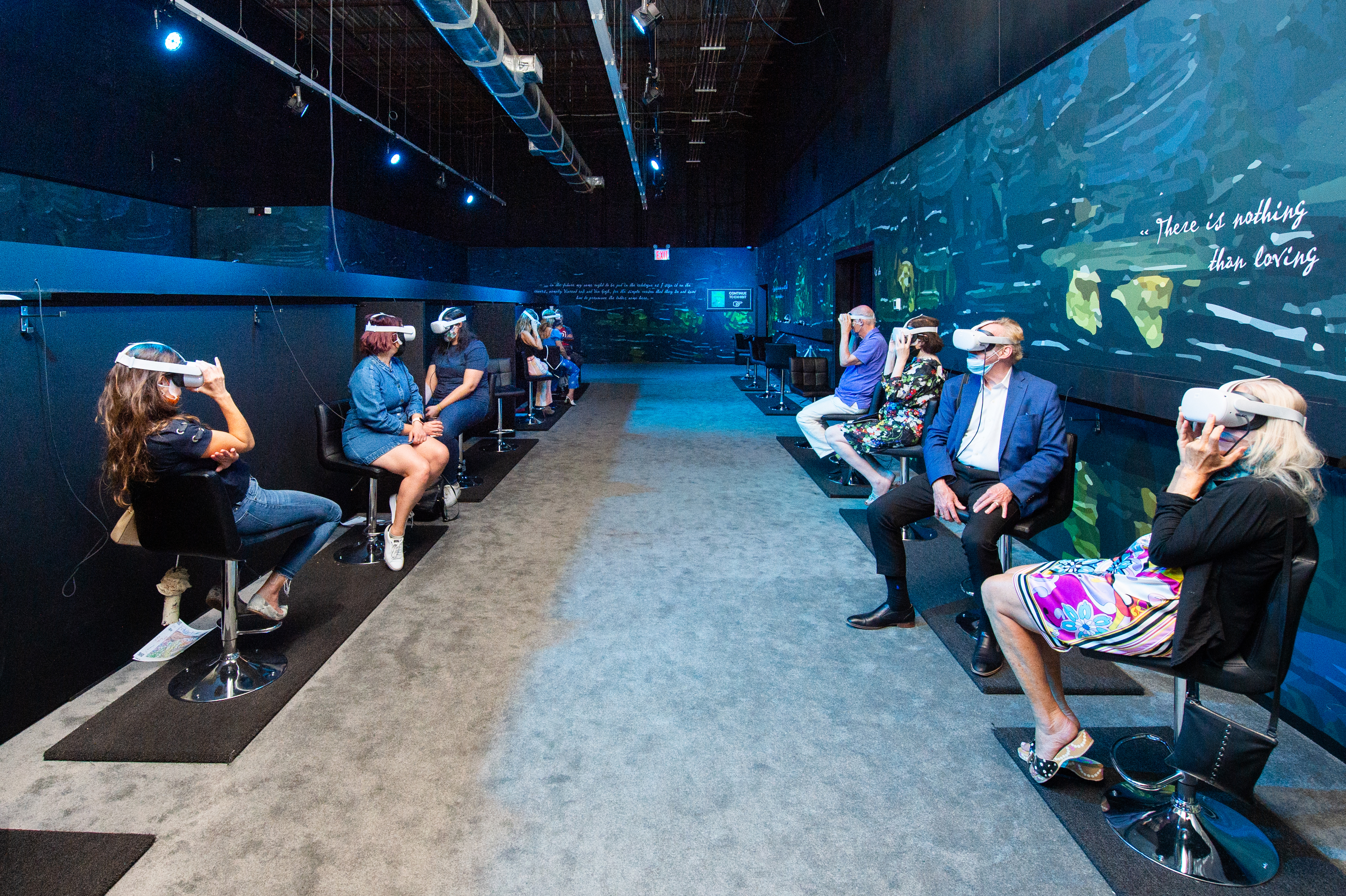Where Digital Media and 19th Century Art Meet
Review of Van Gogh: The Immersive Experience in Seattle
Written by Teen Writer Elle Vonada and edited by Teen Editor Eleanor Cenname

Vincent van Gogh’s oil paintings are well known and honored by almost everyone who knows anything about art. It’s well known that his struggles with mental illness impacted his art. In a rented warehouse on Occidental Street, Van Gogh: An Immersive Experience displays art in a way that makes it accessible to a modern audience using digital enhancements to warp his work into a dynamic performance that captivates viewers.
Near the entry, a summary of Van Gogh’s life hangs next to a sculpture of his head. The figure holds a projection of Starry Night that looks as if it’s growing onto the figure. Having a three dimensional Van Gogh head as the canvas for a two dimensional oil painting beautifully displayed the depth behind Starry Night and showed how Van Gogh saw the stars. Though creative and captivating, the display raises the question: Does this display change his intent behind his original creation? Is this an expression of Van Gogh or the current creators of the exhibit?

There is a similar display with Van Gogh's Vases. A sculpture of a vase stands at the end of a small hallway, and Van Gogh’s flowers interchange with the use of a projector. Again, this is an interesting display, but does it honor Van Gogh’s original creation or mutate it—perhaps both? Among these enhanced works are replicas of Van Gogh’s paintings in their original form: oil on canvas. Exhibit-goers stop to briefly admire his art and quickly move on to more “entertaining” parts of the exhibit. For instance, a 3D model of Van Gogh’s bedroom in the yellow house has audience members transfixed, along with a deconstructed display of Van Gogh’s painting of his asylum. This is a prime example of modern society’s short attention span. With technology, everything we need is at our fingertips. When the internet lags or our Uber is five minutes late, we lack patience. Unpacking Van Gogh’s work may seem unnecessarily time consuming when you can Google a short summary of Irises or have visual aids that interpret his works for you. Van Gogh’s original work is beautiful by itself, and part of me is disappointed we felt the need to cater to our modern eyes. Yet Van Gogh’s work merits a contemporary audience, and if this is the way people want to take in his creation, so be it.
“I want to touch people with my art. I want them to say ‘he feels deeply, he feels tenderly'” Van Gogh wrote. Perhaps using visual aids assists his wishes for his sensitivity to be seen, but maybe we can feel that with the paintings alone. Throughout the exhibit I wondered if any of the visual aids richened or weakened the artist’s work.
At one point, viewers enter a room with work displayed dynamically, wall to wall, using 28 ceiling-mounted projectors. His paintings surround us. Somber music plays in the background and occasionally raindrops fall, creating a dark environment. Parts of his paintings leave their canvas and move the room. His work Two Crabs was displayed, then the crabs walked along the floors and walls as delighted children in the room scurried to “catch” them. They were certainly captivated, but would Van Gogh have approved? We cannot ask what he was feeling when he painted Cafe Terrace at Night or Almond Blossoms. It is fair to question whether it is appropriate to assign emotions to his work and alter his initial purposefulness?

Inherent in displaying an altered form of a dead artist’s work is the uncertainty that their true vision is being portrayed. As an artist, I am defensive on Van Gogh’s behalf; I feel my art is in its intended form when it leaves my hands. “I put my heart and soul into my work, and I have lost my mind in the process,” wrote Van Gogh. He was trapped in his brain, in a reality that was augmented with hallucinations and sadness. His love of painting was an escape for him—it also drove him mad. Perhaps art that has been created with such passion deserves the respect of being shown in its true form and not as a light show. We will never know if Van Gogh would choose to reshape his art given the technology we have today.
At the end of the exhibit is an option to take a virtual reality tour around Saint Rémy, where many of his great works were painted. During the tour, one journeys along the countryside starting at The Bedroom and continuing around Saint Rémy to see where The Siesta, Road with Cypress and Star, Starry Night, and many other paintings were inspired and created. Seeing the town he inhabited for many years and knowing how much he created there was an experience all viewers should partake in if going to Van Gogh: An Immersive Experience.
It’s important to honor a dead artist’s original work while giving them a platform that will best allow their audience to understand their story and struggles. I gained some perspective on Van Gogh’s life looking at his work through the eyes of the Immersive Experience.
Van Gogh: The Immersive Experience is currently on display in downtown Seattle. For more information see here.
Lead photo credit: Photo by Dan Swartz for Exhibition Hub & Fever
The TeenTix Newsroom is a group of teen writers led by the Teen Editorial Staff. For each review, Newsroom writers work individually with a teen editor to polish their writing for publication. The Teen Editorial Staff is made up of 6 teens who curate the review portion of the TeenTix blog. More information about the Teen Editorial Staff can be found HERE.
The TeenTix Press Corps promotes critical thinking, communication, and information literacy through criticism and journalism practice for teens. For more information about the Press Corps program see HERE.

